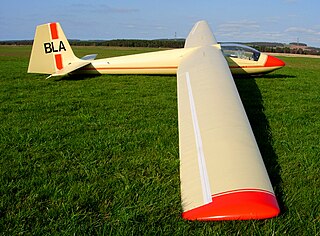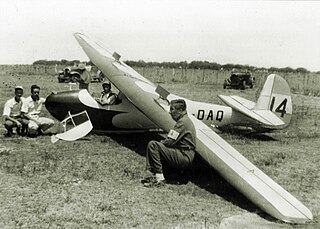| Antonov A-9 | |
|---|---|
 | |
| Role | Single seat sailplane |
| Designer | O.K. Antonov |
| First flight | 1948 |
| Number built | 27 [1] |
The Antonov A-9 was a single-seat sailplane designed and built in the USSR in the 1940s, a development of the record setting Red Front 7.
| Antonov A-9 | |
|---|---|
 | |
| Role | Single seat sailplane |
| Designer | O.K. Antonov |
| First flight | 1948 |
| Number built | 27 [1] |
The Antonov A-9 was a single-seat sailplane designed and built in the USSR in the 1940s, a development of the record setting Red Front 7.
Oleg Antonov had designed sailplanes since the early 1930s, most memorably the Red Front 7 which, flown by Olga Klepikova, set a world distance record of 749 km (466 mi) that stood from 1939 to 1951. The A-9 is seen as a development of that aircraft, though detailed information from this period of Soviet aviation is often limited. The fuselages and tail units of the two aircraft were very similar but the wings were quite different. [2]
The A-9 was a cantilever, shoulder wing monoplane. In plan, the wing had a short, constant chord centre section and long, straight tapered outer panels, with a sweep on both edges, terminating in rounded and downward-curled wingtips. The panels were demountable from the centre section for transport; unusually, the centre section was an integral part of the fuselage structure, its single box spar spanning the 3.2 m (10 ft 6 in) section unbroken. The spar continued beyond the central section-outer panel joint, the whole wing having plywood covering ahead of the spar and aircraft fabric covering aft. Long span, tapered, fabric covered and mass balanced ailerons occupied about ⅔ of the trailing edges of the outer panels; these panels also carried Schempp-Hirth-type airbrakes, placed just behind the spar and ending at the panel mounting joint. The wing section was slightly reflexed towards the rear and thick, with maximum depth far forward at only about 20% chord, making the profile steep-nosed. [2]
The ply-covered fuselage of the A-9 was oval in cross-section, deep ahead of the wings and almost circular to the rear, giving it a pod-and-boom appearance. The fixed tail surfaces were also ply-covered, the fin narrow but with a small fuselage fillet. The control surfaces were fabric covered. In plan the horizontal tail was tapered with sweep on both edges; the broad, curved and balanced rudder reached to the keel and was hinged well aft, almost in line with the elevator trailing edge, for clearance and moment. The upper fuselage line was almost flat, even over the rear part of the long, two piece canopy, though its windscreen curved down sharply into the nose. There was no skid or wheeled undercarriage; instead the A-9 was launched from a wheeled, drop-off dolly and landed on the locally internally strengthened fuselage underside, aided by a tail bumper. [2]
Overall, the structure of the A-9 was heavy and so the wing loading was high at 30.5 kg/m2 (6.2 lb/ft2), [2] compared, for example, with the Slingsby T.25 Gull 4, a contemporary glider with a wing loading of 22.3 kg/m2 (4.6 lb/ft2). [3] Higher wing loadings provide higher speeds and better glide angles between thermals but poor climbing in weak lift. [4] The Red Front 7 is known to have used water ballast on its record flight [4] but the A-9 was not thus equipped. [1]
Because of their speed, the A-9s concentrated mostly on competition flying and record setting. [1]
Data from Sailplanes 1945–1965 [2]
Data from Sailplanes 1945–1965 [2]
General characteristics
Performance

The Slingsby T.43 Skylark 3 was a single seat Open Class sailplane developed from the Skylark 2 with an extended wingspan. It won the 1960 World Gliding Championships.

The Slingsby T.50 Skylark 4 was a British single seat competition glider built by Slingsby Sailplanes in the early 1960s. It sold in numbers and had success at national, though not world level competition.
The Akaflieg Darmstadt D-6 Geheimrat, often shortened to Darmstadt D-6 Geheimrat, was an early competition glider with a single seat and high cantilever wing, designed and built by German University students in 1922.
The Kirigamine Mita is a training glider, seating two in tandem, designed in Japan in the early 1960s. A modified version, first flown in 1966, was produced in modest numbers.
The CVV1 Pinguino was a single seat, high performance glider designed and built in Italy in the mid-1930s, the first of a series of gliders from the Milan Polytechnic. It did not go into production.
The CVV 2 Asiago is a simple, single seat glider designed and built in Italy in the mid-1930s, the second of a series of gliders from the Milan Polytechnic and the first go into production.
The CVV 3 Arcore was a single seat competition glider designed and built in Italy in the late 1930s, a development of the CVV 1 Pinguino. It participated in several national gliding competitions in the short period before the outbreak of World War II.

The Schleicher Rhönbussard, otherwise known as the DFS Rhönbussard was intended as an intermediate glider trainer which could also fly competitively. It was designed by Hans Jacobs in Germany in the early 1930s. More than 200 were built.

The RRG Fafnir 2 São Paulo, named after the legendary dragon and the Brazilian city which partially financed it, was a single seat German high performance glider designed by Alexander Lippisch. It set a new world distance record in 1934 and won the 1937 International Gliding Championships.
The IIL IS-8 was a two-seat sailplane designed by Iosif Șilimon and built in Romania in 1960. They served with Romanian gliding clubs.
The IIL IS-9 was a low powered, experimental pod and boom style motor glider, designed and built in Romania in the late 1950s.
The IIL IS-10 was a high-performance, single-seat glider, designed and built in Romania in the early 1960s. It was the first Romanian aircraft to use laminar flow airfoils.
The RRG Professor was a very early soaring glider and the first to use a variometer for finding thermals. It was designed by Alexander Lippisch in Germany, first flying in 1928. The Professor was widely built by both flying clubs and factories.
The DFS Sperber Senior was a competition sailplane designed and built in Germany in 1936. During 1937 the sole example visited the United States and scored highest in the US National Soaring Competition.
The DFS Sperber Junior was a competition sailplane designed for Hanna Reitsch and built in Germany in 1936.
The Schneider ES-54 Gnome was an experimental low cost glider with a laminar flow but low aspect ratio wing, built in Australia in the mid-1950s. Its performance was predictably poor and only one was completed.
The Merville SM.31 is a French high performance glider with a laminar flow wing, first flown in 1960. Only one was built.
The Musger Mg 9 was a tandem two seat glider built in Austria in the mid-1930s. It broke both world and national records.

Lore and a copy, Musterle, were high performance sailplanes designed at Darmstadt by Paul Laubenthal. Lore was flown successfully by the well known glider pilot Wolf Hirth at the 1929 Rhön (Wasserkuppe) glider competition. Musterle was used by Hirth used to demonstrate the possibilities of "blue sky" thermalling for the first time.
The Laubenthal Württemberg, sometimes known after its constructors as the Akaflieg Darmstadt Württemberg, was a single seat glider designed by Paul Laubenthal and built at the University of Darmstadt for Wolf Hirth, who won four prizes in it at an international competition in France in 1928. A second machine was built in 1929 by the Klemm Leichtflugzeugbau GmbH.